
November 13: Updated with final wave of PSAT scores.
College Board released scores in three waves depending on when students took the PSAT. We have now received scores summaries for all three waves. It is possible that some late scores will still dribble in, but we are not expecting any changes. The results point to a strong upward trend in cutoffs for the class of 2026. You are welcome to jump to the table of estimates below, but we encourage students and families to read more about how we came to those estimates. For more information on the National Merit Program, in general, you may want to read Compass’s National Merit Scholarship Program Explained. If you want to browse almost two decades’ worth of cutoffs, you can find them in Compass’s National Merit Historical Cutoffs.
What is a Semifinalist Cutoff?
Each year almost 17,000 juniors are named Semifinalists in the National Merit Scholarship Program and continue on in the hopes of being one of the 15,000 Finalists and, eventually, one of the 7,500 scholarship recipients. The score needed to qualify as a Semifinalist varies by state and is known as the “cutoff.” Every student scoring at or above the Semifinalist cutoff qualifies. The cutoff is not based on a student’s overall PSAT score but on the Selection Index. The Selection Index is listed on a student’s PSAT score report. It can be calculated by doubling the ERW score, adding the Math score, and then dividing the sum by 10. For example, a 720 ERW / 730 M would have a Selection Index of (720 x 2 + 730)/10 = 217. For the class of 2025, cutoffs ranged from 208 to 223.
What is a Commended Student Cutoff?
If you performed well on the PSAT but do not qualify as a Semifinalist, you have the opportunity to be named as a Commended Student. Unlike the Semifinalist cutoffs, the Commended cutoff is set nationally. For last year’s class it was 208. Approximately 36,000 students are named Commended Students each year.
Why does Compass believe that we are likely to see cutoffs, as a whole, go up?
College Board releases very little data about score distribution. The number of top scorers is the most critical piece of information that we get this early in the process. While we do not know the number of students scoring at a particular Selection Index, we do know the number of students scoring in the 1400-1520 range, which roughly correlates to Selection Indexes of 210-228. The class of 2026 ranks 4th in the ten years since the PSAT scoring was overhauled, and this year sees the highest ever percentage of top scores. The number of Semifinalists and Commended students are capped, so cutoffs are likely to rise. But not all cutoffs. The numbers we have seen are at the national level and there is always churn at the state level. What we believe, however, is that more cutoffs will go up than down.
There is a good correlation between the 1400-1520 band of students and the Commended Student score. We believe that the Commended cutoff will come in between 209 and 211, with a 210 being most likely. Based on our historical archive of Semifinalist and Commended cutoffs, we believe that the average Semifinalist cutoff will go up this year.
Will I find out my status right away?
No. In fact, students don’t learn of Semifinalist status until September of senior year. Compass tracks data on current year performance and historical records to provides estimates and updates between PSAT score release and the Semifinalist announcements. Last year — the first year of the digital PSAT — saw a noticeable uptick in scores. Only one state — South Dakota — saw a lower cutoff versus the previous year’s. Was this a onetime quirk? Based on early results for the class of 2026, we do not believe that it was. The upward trend — whether due to the new test format, recovery from COVID-era learning loss, or other factors — appears to be continuing.
One mistake students make is thinking that the cutoff for one year will be the same in the next year. Cutoffs change every year, sometimes by as much as 5 or 6 points (granted, that’s unusual). Compass emphasizes an Estimated Range, which is likely to include the ultimate cutoff. Within that range, we do provide our Most Likely. That score represents our best estimate based on the known factors, but there are many unknown factors. Most of our PSAT performance data are for national results. So we can usually peg the Commended cutoff within a point or two. States, however, can move in different directions. More Alaskan students may test this year. Some strong Rhode Island prep schools may have decided to stop offering the PSAT. A COVID outbreak in Montana could mean more students using Alternate Entry and entering the competition using SAT scores. Below is a table that shows how many states in each of the last 17 years saw increases, decreases, or no change. There has never been a year where even half of all state cutoffs remain unchanged.
The chart below divides the 50 states into those that saw increases (blue), those that remained unchanged (gray), and those that saw declines (red).
Historically, a change in cutoff is more likely than not. Over the decade from 2015 – 2024, Semifinalist cutoffs remained unchanged only about one-third of the time.
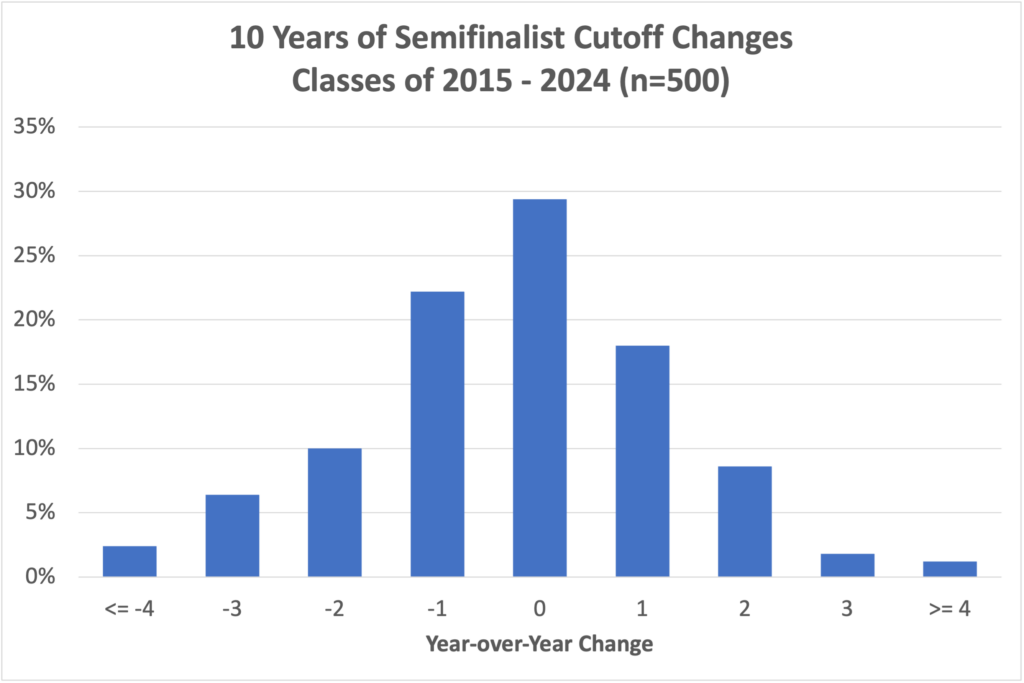
We believe that a table of results from this class will skew to the right.
Small states have more volatile cutoffs than large states, but there can be surprises across the board. The PSAT had a significant overhaul in scoring in 2017. If we look at the minimum and maximum cutoffs during the 9-year period from then until the class of 2025, we see that the 13 largest states (about 100,000 or more high school graduates) average a 2.8-point differential. New Jersey has a 1-point differential, since its lowest cutoff is 222 and highest is 223. The smallest states (fewer than 30,000 graduates) have a 6.2 point differential. Alaska has been as low as 208 and as high as 217! The medium-sized states average a 5-point difference between minimum and maximum.
Here are Compass’s current estimates for Semifinalist cutoffs for the class of 2026:
State | Class of 2026 Estimated Range | Class of 2026 Most Likely | Class of 2025 (Actual) | Class of 2024 (Actual) | Class of 2023 (Actual) | # of 2025 Semifinalists |
|---|---|---|---|---|---|---|
| Alabama | 210 - 216 | 214 | 212 | 210 | 212 | 267 |
| Alaska | 210 - 216 | 214 | 214 | 209 | 210 | 36 |
| Arizona | 215 - 220 | 218 | 217 | 216 | 214 | 401 |
| Arkansas | 210 - 215 | 213 | 213 | 210 | 210 | 134 |
| California | 220 - 223 | 222 | 221 | 221 | 220 | 2103 |
| Colorado | 216 - 221 | 218 | 218 | 216 | 217 | 272 |
| Connecticut | 220 - 222 | 221 | 221 | 221 | 221 | 177 |
| Delaware | 218 - 221 | 220 | 219 | 219 | 218 | 43 |
| District of Columbia | 222 - 224 | 223 | 223 | 223 | 223 | 47 |
| Florida | 216 - 220 | 218 | 217 | 216 | 216 | 972 |
| Georgia | 217 - 221 | 219 | 218 | 217 | 218 | 624 |
| Hawaii | 215 - 220 | 218 | 217 | 217 | 215 | 74 |
| Idaho | 212 - 217 | 214 | 213 | 211 | 215 | 102 |
| Illinois | 218 - 222 | 220 | 220 | 219 | 219 | 738 |
| Indiana | 214 - 219 | 217 | 217 | 216 | 214 | 304 |
| Iowa | 211 - 217 | 214 | 212 | 210 | 212 | 156 |
| Kansas | 213 - 219 | 216 | 215 | 214 | 214 | 142 |
| Kentucky | 211 - 217 | 214 | 213 | 211 | 212 | 202 |
| Louisiana | 212 - 217 | 215 | 214 | 214 | 213 | 238 |
| Maine | 212 - 217 | 215 | 214 | 213 | 215 | 53 |
| Maryland | 221 - 224 | 222 | 222 | 221 | 222 | 296 |
| Massachusetts | 221 - 224 | 223 | 223 | 222 | 220 | 294 |
| Michigan | 216 - 220 | 218 | 218 | 217 | 218 | 511 |
| Minnesota | 216 - 220 | 218 | 217 | 216 | 216 | 288 |
| Mississippi | 210 - 215 | 213 | 212 | 209 | 210 | 155 |
| Missouri | 214 - 218 | 216 | 215 | 214 | 213 | 276 |
| Montana | 208 - 213 | 210 | 209 | 209 | 207 | 45 |
| Nebraska | 210 - 216 | 213 | 211 | 210 | 212 | 118 |
| Nevada | 211 - 218 | 215 | 214 | 211 | 210 | 162 |
| New Hampshire | 214 - 219 | 217 | 217 | 215 | 213 | 55 |
| New Jersey | 222 - 224 | 223 | 223 | 223 | 223 | 474 |
| New Mexico | 209 - 215 | 212 | 211 | 207 | 208 | 94 |
| New York | 219 - 221 | 220 | 220 | 220 | 219 | 1089 |
| North Carolina | 216 - 220 | 218 | 218 | 217 | 217 | 518 |
| North Dakota | 209 - 213 | 210 | 210 | 207 | 209 | 28 |
| Ohio | 215 - 219 | 217 | 217 | 216 | 216 | 582 |
| Oklahoma | 209 - 215 | 212 | 211 | 208 | 211 | 214 |
| Oregon | 215 - 220 | 217 | 216 | 216 | 216 | 205 |
| Pennsylvania | 217 - 221 | 219 | 219 | 219 | 218 | 583 |
| Rhode Island | 213 - 220 | 217 | 217 | 215 | 216 | 50 |
| South Carolina | 210 - 217 | 215 | 214 | 209 | 213 | 234 |
| South Dakota | 209 - 214 | 211 | 208 | 209 | 212 | 41 |
| Tennessee | 215 - 219 | 218 | 217 | 217 | 215 | 319 |
| Texas | 218 - 221 | 220 | 219 | 219 | 219 | 1714 |
| Utah | 210 - 216 | 213 | 211 | 209 | 211 | 195 |
| Vermont | 211 - 217 | 215 | 215 | 212 | 213 | 33 |
| Virginia | 220 - 223 | 222 | 222 | 219 | 221 | 394 |
| Washington | 220 - 223 | 221 | 222 | 220 | 220 | 358 |
| West Virginia | 209 - 212 | 210 | 209 | 207 | 207 | 66 |
| Wisconsin | 213 - 217 | 215 | 214 | 213 | 213 | 289 |
| Wyoming | 209 - 213 | 211 | 209 | 207 | 207 | 24 |
| U.S. Territories | 209 - 211 | 210 | 208 | 207 | 207 | 45 |
| Studying Abroad | 222 - 224 | 223 | 223 | 223 | 223 | 112 |
| Commended | 209 - 211 | 210 | 208 | 207 | 207 |
If you’d like to see even more historical data, you can find cutoffs going back to 2008 in Compass’s National Merit Historical Cutoffs.
Why does each state have its own Semifinalist cutoff if the program is NATIONAL Merit?
This is always a hot button question. NMSC allocates the approximately 17,000 Semifinalists among states based on the annual number of high school graduates. That way, students across the nation are represented. It also means that there are very different qualifying standards from state to state. A Massachusetts student with a 220 might miss out on being a Semifinalist. If she lived 10 miles away in New Hampshire, she would qualify.
NMSC sets a target number of Semifinalists for a state. For example, California sees about 2,000 Semifinalists every year, Michigan 500, and Wyoming 25. In each state, NMSC determines the Selection Index that comes closest to matching its target number of Semifinalists. If 1,900 California students score 222 and higher and 2,050 score 221 or higher, then the Semifinalist cutoff would be 221 (this assumes that the target is exactly 2,000). Because score levels can get crowded, it is easy for cutoffs to move up or down a point even when there is minimal change in testing behavior or performance.
No Semifinalist cutoff can be lower than the national Commended level. Cutoffs for the District of Columbia and for U.S. students studying abroad are set at the highest state cutoff (typically New Jersey). The cutoff for students in U.S. territories and possessions falls at the Commended level each year. Boarding schools are grouped by region. The cutoff for a given region is the highest state cutoff within the region.
Why does the number of top scorers vary from year to year?
While there are changes in the number of students taking the PSAT/NMSQT, there can also be small flaws in test scaling that play a role. Prior to the digital PSAT, a single test form was seen by a large percentage of test takers. Something amiss with that single form could impact selection cutoffs across the country. The digital PSAT is constructed differently. Students receive unique form codes drawn from a large pool of problems. Scaled scores are generated based on the characteristics of those problems. In theory, this should make scores more stable. College Board’s early studies have found an extremely high correlation between the paper-and-pencil test and digital test. Still, even with its adaptive nature, the uncertainty remains as to whether the much shorter test can reliably score students at the 700-760 end of the scale.
What if I missed the PSAT because of illness or other legitimate reason?
You may still be able to enter the scholarship program by applying for Alternate Entry using an SAT score. Find information about last year’s process in Compass’s explanation of National Merit alternate entry.
When are National Merit Semifinalists announced?
The Commended cutoff becomes unofficially known by the end of April. The lists of Semifinalists are not distributed to high schools until the end of August. NMSC sets a press embargo on Semifinalist announcement until mid-September, but schools are allowed to notify students before that date. NMSC does not send Commended Student letters to high schools until mid-September. Compass will keep students updated on developments as those dates approach.
Do state and national percentiles indicate whether I will be a National Merit Semifinalist?
No! Approximately 1% of test takers qualify as Semifinalists each year, so it is tempting to view a 99th percentile score as indicating a high enough score — especially now that College Board provides students with percentiles by state. There are any number of flaws that rule out using percentiles as a quick way of determining National Merit status.
- Percentiles are based on section scores or total score, not Selection Index
- Percentiles are rounded. There is a large difference, from a National Merit perspective, between the top 0.51% and the top 1.49%
- Percentiles reveal the percentage of students at or below a certain score, but the “at” part is important when NMSC is determining cutoffs.
- The number of Semifinalists is based on the number of high school graduates in a state, not the number of PSAT takers. Percentiles are based on PSAT takers. States have widely varying participation rates.
- Most definitive of all: Percentiles do not reflect the current year’s scores! They are based on the prior 3 years’ performance. They are set even before the test is given. And if you are going to use prior history, why not use the completely accurate record of prior National Merit cutoffs rather than the highly suspect percentiles?
Entry requirements for National Merit versus qualifying for National Merit.
Your PSAT/NMSQT score report tells you whether you meet the eligibility requirements for the NMSP. In general, juniors taking the October PSAT are eligible. If you have an asterisk next to your Selection Index, it means that your answers to the entrance questions have made you ineligible. Your answers are conveniently noted on your score report. If you think there is an error, you will also find instructions on how to contact NMSC. Meeting the eligibility requirements simply means that your score will be considered. Approximately 1.4 million students enter the competition each year. Only about 53,000 students will be named as Commended Students, Semifinalists, Finalists, or Scholars. See National Merit Explained for more information.

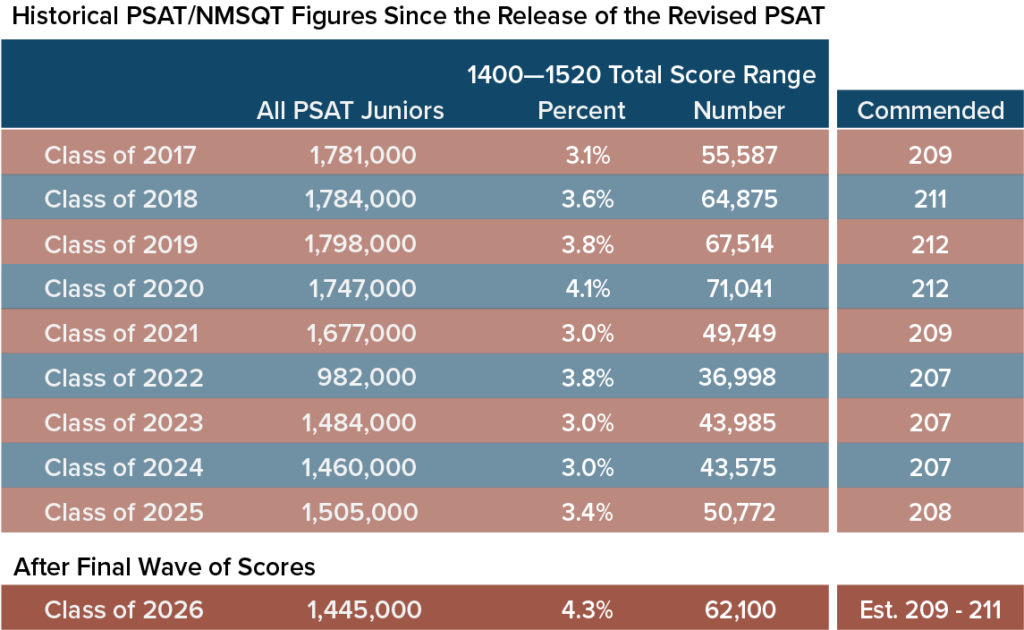
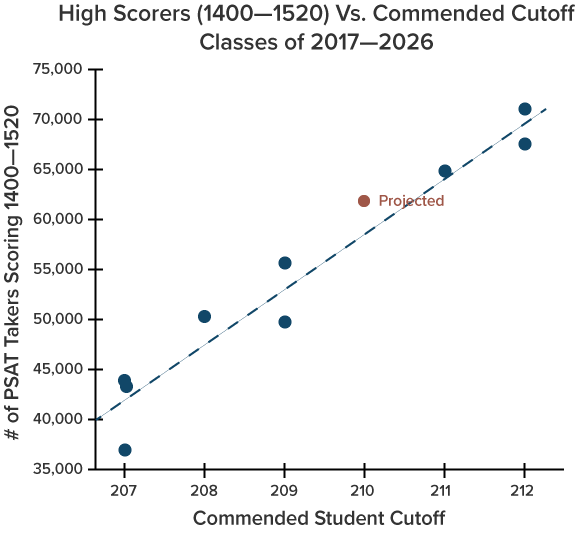
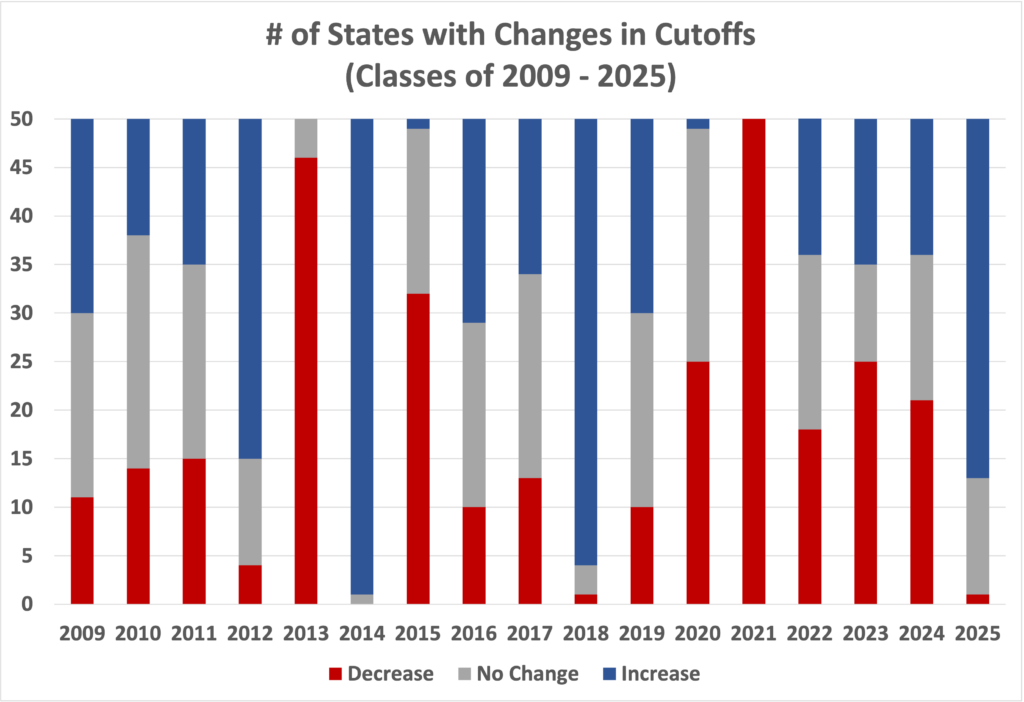
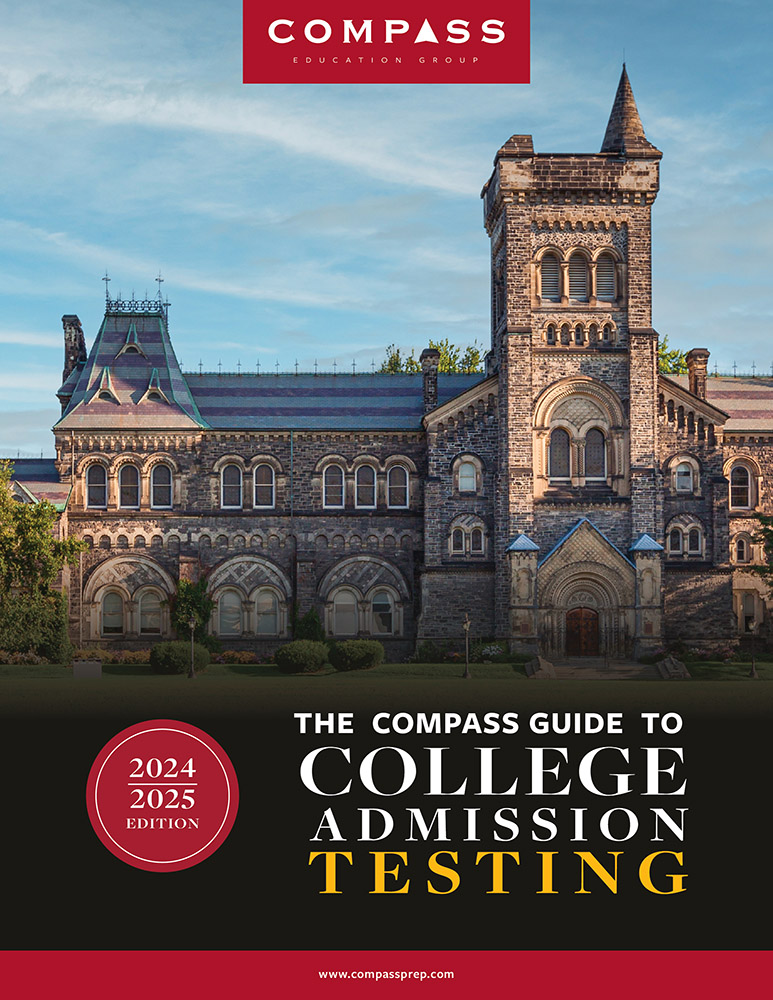
Hello Mr. Sawyer,
My score was 221 in CA. What made you change your most likely from 221 to 222 as the cutoff?
Thank you.
Ana,
I believe my Most Likely for CA has been at 221 for a while. It’s certainly possible that we’ll see a recovery to 222, but most indicators point to a low year for cutoffs.
Anxiously awaiting the Minnesota cutoff!!
Anyone have news for Minnesota??
Nothing yet, Sara.
Hi Art,
For Minnesota, is your cutoff prediction still 219? Any update?
Thanks!
David,
I’ve updated my Most Likely to 218. We’re probably going to see it fall in the 217-219 range.
Hi,
I got a 214 from WI. What would be my chances of getting selected? I see that the last year’s cutoff for WI was 214, but how often does it fluctuate?
Shreya,
Even in years where the Commended cutoff is unchanged (as in this year), about half of the state cutoffs go up or down. You only need to worry about it going up, of course. I’d say your odds are good (70-80%?), but it’s tight enough that you’ll want to keep your fingers crossed come late August.
Hi Art,
In ID would a 215 PSAT score qualify for SF, and if so, would a 1480 SAT be high enough? Do they ever look at ACT scores (score of 34) or is it only the SAT?
Thanks!
Anon,
A 215 will likely qualify as Semifinalist in Idaho this year. As a confirming score for the Finalist selection, NMSC makes a Selection Index from your SAT or ACT score (the procedure for the ACT gets complicated) as detailed here. The cutoff is usually set at the Commended level, so your 1480 should produce a high enough score no matter the ERW/M split.
Art, you have “detailed here” as if it’s supposed to be a link, but it’s not a link in my browser. Can you please provide the actual URL in your comment so I can review? Our daughter’s ACT is definitely better than her SAT, so we’d like to research the process for the selection index based on ACT scores. Thank you!
Sorry, Gordon. You can find the information in our National Merit: https://www.compassprep.com/psat-national-merit-faq/
Is there any benefit to getting a 214 in California? CLass of 2023 and not sure if I should be looking out for anything.
Alex,
It’s an achievement that will reward you with a Commended Student honor. While most scholarships are associated with Finalist status, you can list your Commended status on your college applications.
Hi Art,
I’m from Illinois and my Selection Index is 219, the same as the “Most Likely” cutoff. Given that the cutoff for Commendation is lower than usual this year, what do you think my chances of becoming a Semifinalist are?
Eric,
My Most Likely estimate takes into account the weak year (there is also a good argument for 218). The good news is that Illinois has never gone above 219 in “low” years. The caveat is that until Illinois switched to the P/SAT as the state-sponsored exam, its cutoffs were lower, so the historical record means a bit less. I’d say that your chances are 70-80%.
Hi Art,
2 questions:
1. If a student takes the PSAT NMSQT as a homeschooler in junior year, and then they decide to enroll full-time in public school for their senior year, if their PSAT score is high enough to become a NMSF, are they treated as a homeschooler within the process to move to Finalist since they were a homeschooler when they actually took the test?
Or, would they be treated as a public school student since that is what they will be when the score shows up in September?
Asking because who writes the Student’s Recommendation Letter will be determined by this. The public school principal or someone at the school is supposed to write the Recommendation Letter for full-time public students. Homeschool students handle the Recommendation Letter by choosing someone who knows them well.
Different Student:
2. If a student takes an AP Test and knows they did very poorly on it, likely scoring a “1”, and this student’s PSAT score has a very good chance of qualifying them as a National Merit Semifinalist, should they cancel this AP score before it comes in? The score is not the student’s fault. The instructor did not cover 1/2 of the coursework. The classroom is chaotic every single day. The student studied a lot outside the classroom but is almost certain their score will be extremely low. It’s likely the entire class scored a “1”.
All other test scores are reported on the transcript, which makes us think that AP scores will also be reported there. The student does not want this score considered as part of the National Merit Finalist Application or for it to be seen by any university admissions or scholarship personnel, when the time comes.
The student is wondering if it is worse to score a “1” or if it would be seen as worse to remove it and not report it altogether. They know that earning a “C” on a grade card can make a student ineligible for National Merit Finalist, and it seems like scoring a “1” on an AP test would be viewed as just as bad or even worse. Or is there a way to give a statement regarding the score? This student usually scores in the top 99% of all test takers. First time for this. (The student has over 100% in the class as a grade.)
Thank you.
Barbie,
1) I haven’t encountered this situation. Transfers — homeschoolers or otherwise — are not uncommon, so I’m sure that NMSC has set guidelines about whether the junior or senior year status applies. I recommend contacting them directly.
2) AP scores are not used by National Merit. When you say that the test scores are reported on the “transcript,” I’m not sure if you mean the school’s transcript or the student’s College Board record. It’s considered bad form for schools to put scores directly on a student’s transcript, but some schools do it nonetheless. AP scores are sent separately from SAT scores, and a student has the option of withholding or canceling scores. Find out more about those options in College Board’s FAQ. There would be no reason to directly send AP scores to National Merit.
Hi, Mr. Sawyer,
Do you have an idea when the official NMSF names will be announced? Thank you!
Wei,
Names have been sent to schools, but there is no generally agreed upon way of notifying students. Most students will receive word from their counseling department or principal between now and the second week of September.
Do you mean that students won’t receive notifications from college board?
That’s right. National Merit, not College Board, sends out notifications, and the notifications go directly to schools.
Thanks!
215 qualified in Kansas.
Thank you!
Does a lower Florida cutoff than expected signal that other states will also tend to the lower end of the range? Speaking as a 221 from CA.
Alisa,
While one state doesn’t indicate a trend, it’s nice to see a big state such as Florida come in low.
Hi Art. Do you know if CB generally sends all the letters for every state out around the same time or do they batch them by state or region? If the former, most schools should have the scores within a couple days, if the latter entire states many not have had letters sent yet, etc. Thanks.
J,
National Merit mails everything at the same time from its headquarters in Illinois, and yet there have been years where Illinois schools have been among the last to receive letters. The USPS gets the job done, but on its own inscrutable schedule.
If the chart shows 43,985 students were in the high scorer range of 1400-1520…and the top 50,000 kids get commended or better…wouldn’t that mean even some kids under 1400 would get commended? My son got 1400 and a 206, which sounds like he’s one of the 43,985 high scorers but below the cutoff and won’t get commended.
Jen,
National Merit doesn’t use the combined score (the 1400 – 1520). [We cite it in the article because it’s the score range that College Board releases.] Instead, NM uses the Selection Index, which puts twice as much weight on the Reading and Writing (ERW) score than on the Math score. Your son, I believe, scored a 660 ERW and 740 M to give him a 1400 combined score and a 206 SI (66 x 2 + 74). A student scoring 700 ERW and 700 M would have received an SI of 210 (70 x 2 + 70). There were enough students scoring lower than 1400 but with SIs above 206 that your son did not qualify. For example, a student scoring 750 ERW and 620 M would have a combined score of 1370 but an SI of 207.
That all makes sense, thank you for the response!
216 qualified in Alabama!
Congratulations, B! Thank you for sharing.
Thank you for all you do to support and encourage families as we travel this path. You do a fantastic job and are greatly appreciated.
Congrats! I wish our school would announce it. Also hoping it’s below 216 (AL).
I’m guessing 212/213 for Alabama myself. I hope that will be what you need.
216 Qualified in TN.
Thank you, Priscilla. I hope that was good news for you!
Apologies if this is obvious and I’m missing it. What is the “given Selection Index” referenced in the legend? (<= indicates that the cutoff is equal to or lower than the given Selection Index)
I was thinking it was the "Most Likely" number in the table for 2023, but Alabama's confirmed cutoff is higher than Compass' estimated number, and Kansas' is lower.
Alabama is not yet confirmed (AFAIK). The less than or equal means that we know the HIGHEST that the cutoff could be is less than or equal to 216. If someone qualifies at 214, then we would know the cutoff is <= 214. It's not until we hear from someone who has not qualified that we can say we know the cutoff for sure. [Or we hear the cutoff from a counselor.]
Ah, got it. Thank you!
Thanks for all this information. It appears that you will use “=” to indicate that you can confirm what the state’s actual cutoff is, and that you will use “<=" or "=<" when you have anecdotal information regarding a state from a reader based on their child's actual score, but you are not able to confirm that state's cutoff lies. In the latter cases, the cutoff could still be quite a bit lower (or higher) than the score one student reported. Is that accurate?
That’s right GC. We don’t know the exact cutoff until we hear from someone who did NOT qualify. Or we hear from a counselor who has confirmed the cutoff as received from National Merit.
219 qualified in Texas. We homeschool and just got the letter in the mail.
Congratulations to your student! Thank you for posting, Jennifer. That will be a relief to a lot of students in Texas.
It was such relief for us too so I was excited to share for all those waiting to hear! Thank you for keeping the list up to date for us!
Thanks Jenifer!
yes this is a huge relief. Thank you Jennifer!
Thank you for the update, Jennifer!
Yes, big relief! Thank you for sharing!
Thank you for sharing Jennifer! Was anxiously waiting here in Texas!
This is for semifinalist right? Because I got a 219 too!
That’s right, Leul.
My daughter’s 214 qualified in Arkansas.
Qualified as a 214 in AL!
Congratulations, J! I’m away from my computer but will update the page shortly.
A 217 qualified in Indiana
Congratulations, Aarush!
215 qualified in Indiana too
Thanks, Chloe.
221 qualified in California
That’s more good news for a lot of students. Thank you, Vernon!
Do you think there is any chance a 220 may qualify in CA?
Andrea,
Yes, I think a 220 is in play in California.
My son has 220 in Texas and he hasn’t heard from his school yet. Who should he be contacted, if at all?
Notifications have been mailed to school principals. It often takes time for schools to notify students, especially at the beginning of the school year. Congratulations to your son! I’m sure that he’ll eventually get the good news.
Hello, I have a 219 and I am from Texas. Am I semifinalist?
Thanks
AJ
Yes, that’s my understanding. Anyone with a 219 or higher will be a Semifinalist in TX. It’s still possible that the cutoff is even lower.
Thanks a Bunch!
Hi Art,
I am from Texas with a 218. Any chance at all that this could make the cutoff?
Technically we still don’t know the cutoff, so it could be 218. Unfortunately, it’s been about a decade since Texas came in at 218.
Missouri had a 215 qualify
Thank you!
Missouri <=215
Thanks, Clemente.
Hi Art!
First of all, I would like to thank you for your amazing work cataloging all of this, I have been looking at it for a while. I’m a Florida student who has just recently qualified with a 216!!! I am so excited because of the Benacquisto scholarship, but I have a question I hope you’d know the answer to. The eligibility requirements say you have to be a National Merit Scholar, which includes the National Merit awards, corporate-sponsored awards, and college-sponsored awards. I’m interested, though, how likely it is that I would get a college-sponsored award? let’s say, for example, my first choice was the University of Central Florida. Considering I don’t have any sort of disciplinary record or extenuating circumstances, would they have a reason to not grant me their college-sponsored scholarship? Would love to know your thoughts on this, thank you!
Congratulations, Ryne! Yes, the Benacquisto is a great program for the participating Florida schools. In order to qualify as a Scholar, you first need to be named a Finalist. If you were to then list UCF as your first choice with National Merit, you would receive a scholarship. In order to become a finalist, you need a “confirming” SAT or ACT score (see our FAQ for more info), a completed application (you’ll receive this information from your high school), a recommendation from your school, and “a record of very high academic performance.” It’s that last one that National Merit leaves vague. About 15,000 of 16,000 NMSFs become Finalists.